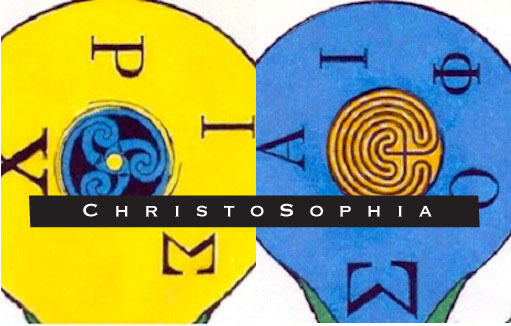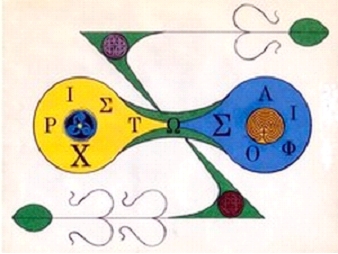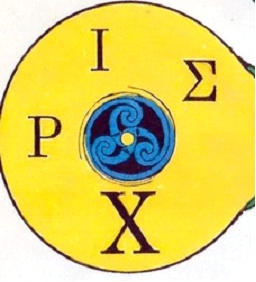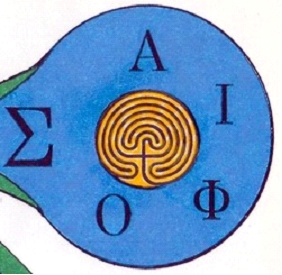.

.







The ChristoSophia symbol
The ChristoSophia symbol is derived from an ancient Pictish symbol - the "double disk" and "Z-bar." The Picts were the people of northern and eastern Scotland who were the precursors of the "Scoti" or settlers from Ireland. Little is known of the Pictish symbols; they are very prevalent and found on stones, some large, some small, throughout the Pictish homeland in Scotland. Our first pilgrimage to see them was in 1994. In Aberlemno, a village between Dundee and Aberdeen, we discovered what was to become the ChristoSophia symbol on a large monolith by the roadside. We were immediately drawn to it by its essence of dynamic wholeness and balance. After returning from pilgrimage, we meditated upon its meaning for our work, and the complete image as it now appears came to us. In the "double disk," the words Christos and Sophia appear in their original Greek letters-the last letter of Christos being the first letter of Sophia signifying their interconnectedness. If we envision the symbol on our chest, Christos is on our right breast and Sophia on our left. The omega at the center is over our heart. The color of the Christos is the golden yellow of the sun. The color of the Sophia is the deep blue of the sea and sky. Where they meet at the center their union is the vibrant green of Nature. The letters of their sacred names flow in the lemniscate or infinity sign-the never-ending source and manifestation of Creation. Christos means "the Anointed One" and Sophia means "Wisdom", indicating to all humanity that we are anointed with wisdom. This is a central tenet within traditional Christian doctrine. When Jesus was baptized by John, he became the "Anointed One." The image of the dove descending upon him was the symbol for Divine Wisdom - Sophia. Hence, the symbol of ChristoSophia is a constant reminder that we are continually anointed by the flow of Divine Wisdom which centers in our heart. The manifestation of the anointed wisdom is Love.
In the center of each sphere of the double disk are two symbols which do not appear in the original Pictish image. These symbols came to us in our original meditation and are reminders of additional aspects of ChristoSophia in our lives. The symbol at the heart of Christos is the "triskele," a Celtic symbol of the three-fold goddess, the three stages of human life, and the three aspects of the material world-earth, sea, and sky. The Celtic Christians adopted this ancient symbol for the dynamic flow and power of the Trinity. It can be found in many Celtic Christian masterpieces such as the Book of Kells. The symbol at the heart of the Sophia sphere is the labyrinth, a symbol of the Divine Feminine from ancient pre-Christian times. The labyrinth reminds us of the back-and-forth path of the life we live in the body. As we progress forward through the grace of ChristoSophia, we draw closer to the Center.
The "Z-bar" likewise presents us with a reminder of the dynamic flow of life and all creation.
As human beings we have the opportunity and the responsibility to create a higher octave of spiritual being in creation by assimilating that which is "earthy" and transmuting it into that which is Good, Beautiful, and True. All this takes place at the Center, the Heart, the Omega, where the "Z-bar" and "Double Disk" intersect. Thus, in the ChristoSophia symbol, the lower left arm of the "Z-bar" represents that which is "earthy" which we draw in and raise up as Moses did with the brazen serpent. We can see the resemblance of the "Z-bar" to a serpent (although the Picts had a separate symbol for the serpent on their symbol stones). We transmute this energy by the anointing of Wisdom and then broadcast it out into the cosmos at a higher level, represented by the upper right bar of the "Z-bar."The wavy lines on the horizontal beams of the "Z-bar" are on the original Pictish symbol. In our interpretation, they are like resonators. The lower ones "receive" the earthly emanations and the upper one "broadcasts" the transmuted energy into the cosmos.
We may also consider the "Z-bar" as an analogy for a lightning flash. Many of the Pictish symbol stones show the "Z-bar" in a more vertical alignment. Lightning is that which restores equilibrium between opposing polarities. It also symbolizes the flash of insight-enlightenment-that often occurs from deep contemplation, This is akin to the experience of "satori" in Zen Buddhism. Modern science knows that the "flash" of lightning travels through a sheath of non-visible energy which occurs nanoseconds before the visible lightning. The sexual imagery of this action is another reminder of the sacredness of human sexuality. Institutional Christianity has had a long history of misguided attitudes towards sexuality. The ChristoSophia symbol is meant to encourage human beings to embrace the divinity of the union of male and female, masculine and feminine: ChristoSophia.
Back to top

Christos means "the Anointed One" and Sophia means "Wisdom", indicating to all humanity that we are anointed with wisdom.








